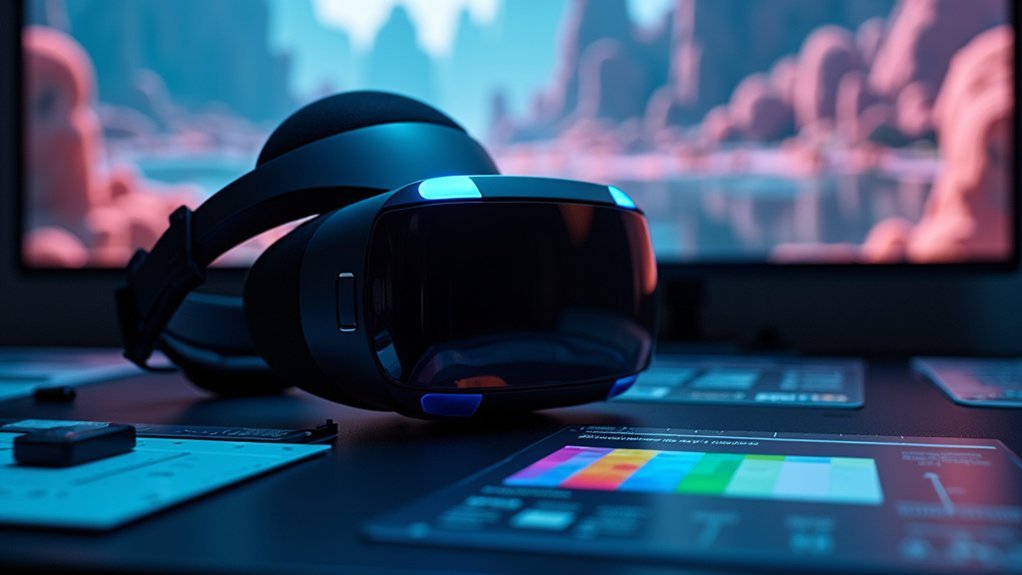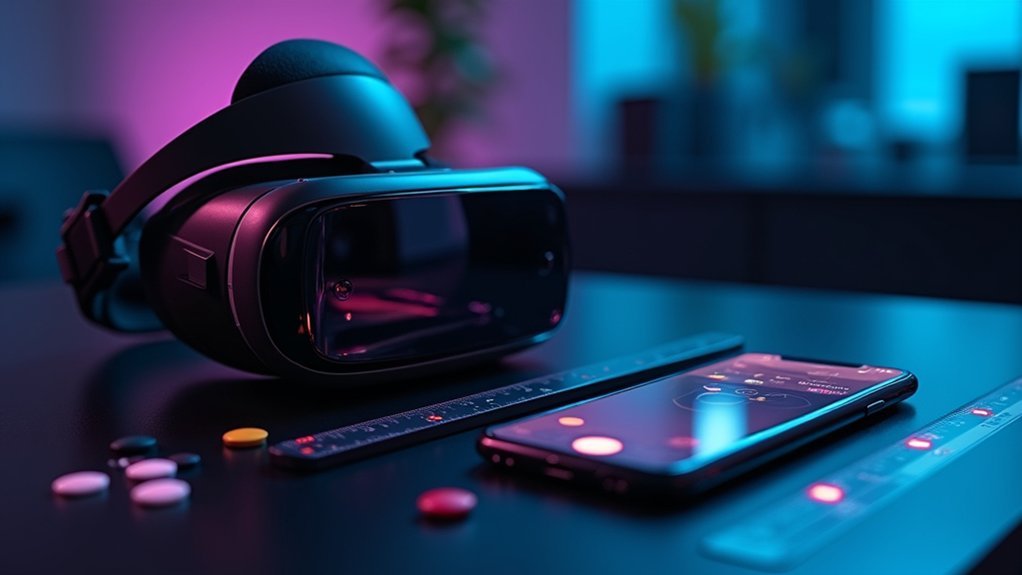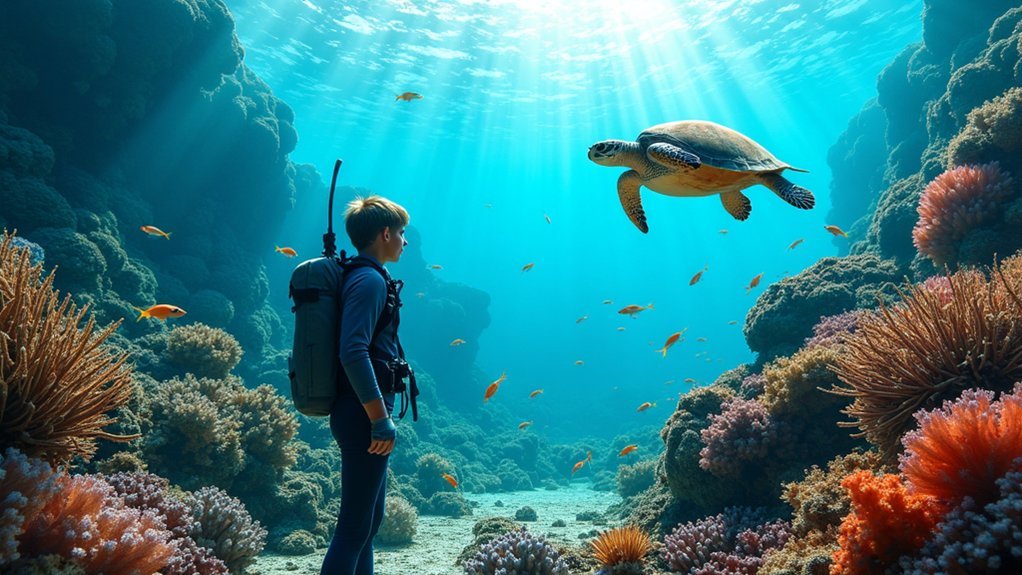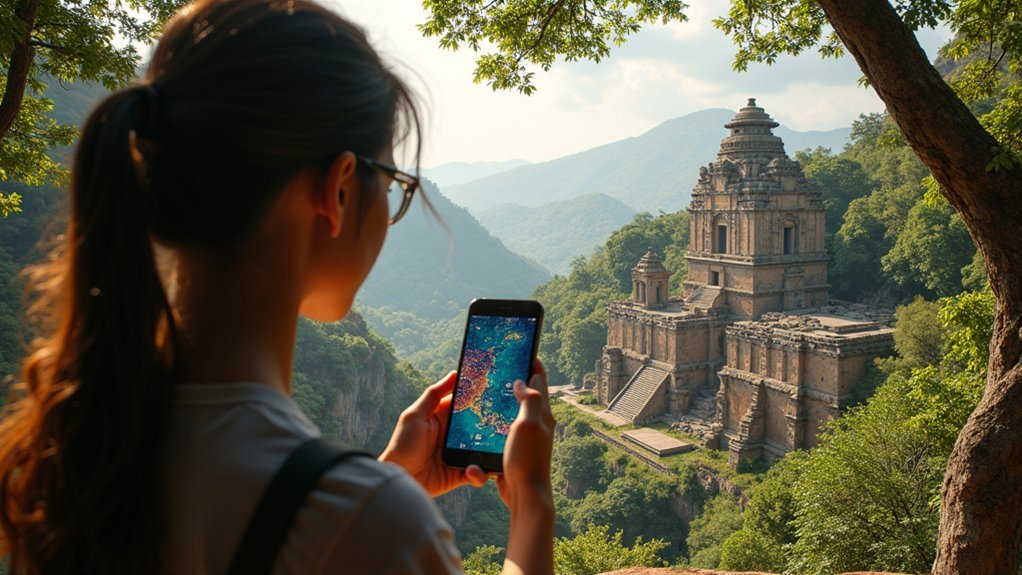Proper VR motion calibration guarantees immersive experiences while preventing discomfort and strain. Start by mounting base stations at least 2 meters high, angled 30-45 degrees downward. Position trackers on key body joints and calibrate in T-pose for full-body precision. Maintain consistent lighting, minimize reflective surfaces, and regularly update firmware. Clean controllers with microfiber cloth and check battery levels frequently. Discover how advanced techniques like AI-assisted calibration can take your virtual reality adventures to the next level.
Why Precise Motion Calibration Matters in VR

While many users focus on display quality and processing power, precise motion calibration forms the bedrock of any effective VR experience. When your system is properly calibrated, virtual objects and movements align perfectly with your real-world actions, dramatically enhancing immersion and reducing frustration.
Calibration isn’t just about comfort—it’s vital for safety and effectiveness. Without it, you might develop compensatory movements or strain yourself trying to interact with misaligned objects. For rehabilitation or training applications, precise calibration guarantees you’re practicing the correct motions and receiving accurate feedback.
Beyond individual sessions, proper calibration enables consistent experiences across multiple uses, supporting reliable data collection and measurable progress in therapeutic or educational contexts.
It’s the invisible foundation that makes every other aspect of VR work seamlessly.
Step-by-Step Full-Body Tracker Setup Guide
Setting up full-body tracking in VR requires careful preparation and attention to detail if you want responsive, accurate movement representation.
Start by selecting compatible equipment: HTC Vive trackers, Base Station 2.0 units, and appropriate straps for mounting to your body.
Mount base stations in opposite corners at least 2 meters high, angled 30-45 degrees downward to maximize coverage.
Confirm all trackers are paired and detected in SteamVR before attaching them securely to your hips and ankles.
Launch your VR application and locate the calibration mirror or menu.
Position yourself in T-pose so tracker indicators align with your avatar’s body points.
Press both controller triggers to complete calibration.
For troubleshooting, check tracker placement, adjust play space height, and confirm trackers maintain line-of-sight with base stations.
The blue logo Vive trackers from 2018 are highly recommended due to their superior compatibility with most base station setups.
Optimizing HMD Calibration for Immersive Experiences

To achieve the most immersive VR experience, you’ll need to master precision alignment techniques that guarantee your headset’s virtual world perfectly matches your physical movements.
Proper vision-tracking enhancements require maintaining consistent lighting conditions during calibration while regularly updating your device’s firmware for peak performance.
You can further improve your experience by using manufacturer-provided calibration tools that fine-tune sensor alignment and camera positioning for more accurate hand and object tracking.
Precision Alignment Techniques
Achieving ideal immersion in virtual reality depends heavily on precise calibration techniques that align the head-mounted display (HMD) with your physical movements. To guarantee accuracy, you’ll need to master coordinate alignment using VR controllers or ArUco markers to properly sync virtual and physical space.
Crosshair alignment requires your careful focus as you match visual elements precisely. Don’t overlook physical adjustments to your HMD—proper fitment considerably impacts calibration quality.
When working with simulators, precise alignment between your headset and the simulator’s coordinate system is essential for realistic interaction.
Remember that individual variations in head shape and size affect calibration. You’ll need to customize your alignment approach based on your unique fitment requirements to achieve the most accurate and comfortable VR experience possible.
Vision-Tracking Enhancements
While basic calibration guarantees functional VR experiences, advanced vision-tracking enhancements dramatically improve immersion through precise eye movement detection.
Scene model-based self-calibration leverages your head position and 3D environment data to estimate gaze parameters without external markers.
You’ll benefit from fixation-based calibration that detects when your eyes focus on specific points using I-VDT algorithms adapted for 3D scenes. This approach minimizes dispersion of points of regard on surfaces during fixations, achieving accuracy of approximately 2.1 degrees.
For best results, verify your VR system can identify fixations as periods when your gaze clusters on single object points despite head movement.
Commercial systems like HTC Vive Pro Eye offer built-in procedures, but integrating automated self-calibration methods can continuously enhance tracking during your VR sessions.
Advanced Multi-Point Tracking Configurations
Multi-point tracking represents the cornerstone of immersive VR experiences where precision matters. By positioning trackers on key body joints—hips, legs, and arms—you’ll achieve full-body avatar precision that mirrors your exact movements.
Today’s calibration tools let you dynamically adjust tracking points to align your virtual limbs perfectly. You’re not limited to standard poses either—the system supports sitting or lying down by repositioning trackers during calibration.
Even in limited physical spaces, advanced calibration guarantees accurate tracking results.
For complex setups, utilities like OpenVR Advanced Settings and Space Calibrator help refine your calibration. This multi-point approach works across major headsets including Valve Index, HTC Vive, and Meta Quest devices, with optional SteamVR Vive trackers greatly enhancing precision for professional applications. Mocap Fusion combines these different sensor inputs to create detailed motion capture suitable for artists and animators wanting to export professional-quality animations.
Troubleshooting Common Calibration Issues

When you notice your virtual limbs aren’t properly aligning with your real movements, first check for sensor occlusion and recalibrate your equipment by performing a quick full-body pose.
If your tracking begins to drift during extended sessions, restart your VR system and guarantee your base stations haven’t been bumped or moved from their calibrated positions.
You’ll also want to verify that no reflective surfaces or bright light sources are interfering with your sensors, as these environmental factors commonly cause both limb misalignment and sensor drift issues.
Limb Misalignment Fixes
Despite your best setup efforts, VR motion tracking can sometimes produce frustrating misalignments between your physical movements and their virtual representation.
These issues often stem from body shape variations, improper strap fitting, or inconsistent calibration poses.
To fix misalignments, try adjusting your A-pose with consistent leg angles during calibration.
Enable compensation functions for upper leg deformations if available in your software.
When standard approaches fail, test tracker placement on the outer side of your legs or directly against your skin for improved results.
For persistent issues, switch to S-pose calibration for better deformation compensation.
Use 3D previews to make real-time adjustments to lateral tilt settings.
Remember that magnetic interference from nearby electronics can affect tracking accuracy, so move to a clearer space if necessary.
Sensor Drift Solutions
Beyond limb misalignment issues, sensor drift represents one of the most common and frustrating problems in VR motion tracking. This gradual deviation of sensor readings can make objects appear to float or move independently in your virtual environment.
To tackle sensor drift efficiently:
- Optimize your physical space by removing reflective surfaces, turning off nearby Bluetooth devices, and ensuring even lighting throughout your play area.
- Maintain your hardware regularly by cleaning controllers with a microfiber cloth, checking battery levels, and handling components carefully to prevent physical damage.
- Leverage software solutions by running calibration tools to realign sensors, updating firmware regularly, and adjusting offset settings to compensate for accumulated errors.
If problems persist after these steps, check for electromagnetic interference or contact professional support.
Calibration Best Practices for Different VR Applications
Achieving ideal VR experiences requires tailored calibration approaches based on your specific application needs.
For seated experiences, optimize eye origin calibration and maintain proper height settings to preserve immersion.
Standing applications benefit from floor origin calibration that matches your physical environment.
Always prioritize 1:1 movement mapping and avoid manipulating head tracking gain.
Entertainment VR may tolerate faster movement speeds, while industrial or training applications require precise real-world movement matching.
For multi-user environments, implement user profiles to quickly switch between calibration settings.
Automate calibration steps where possible, but don’t skip critical adjustments like IPD settings.
Remember that stationary viewpoints reduce motion sickness, and user-initiated movements always feel more natural than forced camera movements.
Computer Vision-Assisted Calibration Techniques
Advanced calibration techniques now leverage computer vision to transform VR setup precision. Using variable weighted least-squares algorithms, these systems simultaneously update both camera and object models, compensating for initial calibration inaccuracies while reducing manual intervention.
Computer vision calibration offers distinct advantages for your VR setup:
Computer vision calibration revolutionizes VR environments with unparalleled precision and adaptability that traditional methods simply cannot match.
- Line-based detection provides more reliable calibration than traditional point-based methods, especially in dynamic environments.
- AI and deep learning integration enables self-calibration that adapts to changing conditions, eliminating the need for static patterns.
- Real-time refinement through probabilistic models continuously improves spatial accuracy, particularly valuable for applications like autonomous vehicles and drone navigation.
These semi-automatic processes greatly enhance calibration efficiency, making them ideal for environments where traditional methods struggle to maintain accuracy.
Field of View Adjustments for Realistic Distance Perception
Proper field of view (FOV) calibration stands as a cornerstone of realistic virtual reality experiences. When your FOV settings don’t match physical reality, you’ll likely underestimate distances by up to 30%, creating a “minification” effect where objects appear smaller and farther away than they truly are.
To calibrate accurately, you’ll need to sample your entire visual field using dynamic object tracking methods. Move calibration objects throughout your headset’s view volume while ensuring good lighting conditions, minimal motion blur, and clear imagery.
For best results, match virtual dimensions to real-world equivalents, providing familiar size cues that your brain recognizes.
Remember to calibrate both eyes separately and repeat the process periodically. Precise FOV adjustment directly impacts your comfort, immersion, and ability to interact naturally with virtual environments.
Frequently Asked Questions
How Often Should I Recalibrate Trackers During Extended VR Sessions?
You should recalibrate trackers every 2-3 hours during extended sessions, or immediately if you notice drift or positional inaccuracies. Quick single-tracker recalibrations are often sufficient unless you’ve moved base stations.
Can I Calibrate VR Motion Using Only Smartphone-Based Tracking Solutions?
Yes, you can calibrate VR motion using smartphone-based tracking, but you’ll face limitations in accuracy, latency, and stability compared to dedicated VR hardware. It’s feasible for basic experiences but not professional applications.
Does Tracker Battery Level Affect Calibration Accuracy?
Your tracker’s battery level doesn’t directly affect calibration accuracy, but low battery can cause tracking inconsistencies or unexpected disconnections during calibration. Keep your trackers well-charged for the most reliable results.
How Do Different Floor Surfaces Impact Motion Tracking Precision?
Your floor surface greatly impacts tracking precision. Hard, non-reflective surfaces work best, while soft, shiny, or patterned floors can confuse sensors, causing bouncing artifacts and misalignment in your movements.
Are There Height or Body-Type Limitations for Standard Calibration Procedures?
Yes, standard calibrations struggle with extreme heights and non-average body types. You’ll notice tracking errors if you’re very tall, short, or have unusual proportions, often requiring manual adjustments to achieve proper avatar alignment.
In Summary
You’ve now mastered the essential techniques for calibrating your VR setup. With properly aligned trackers and optimized settings, you’ll enjoy more immersive experiences with minimal drift or tracking issues. Remember to recalibrate whenever your environment changes and test different configurations for your specific applications. The difference between basic and fine-tuned calibration isn’t just technical—it’s the difference between using VR and truly living it.





Leave a Reply